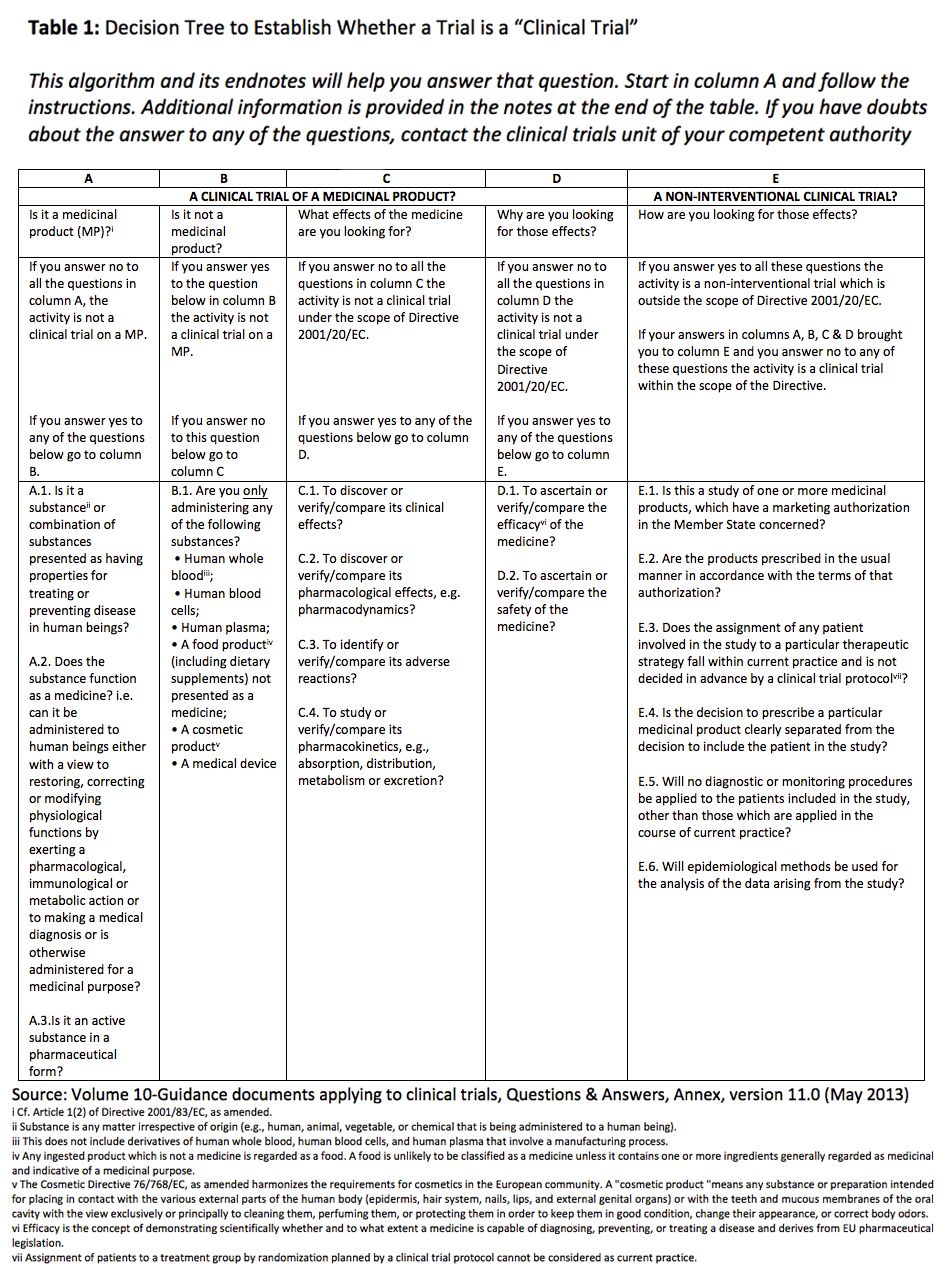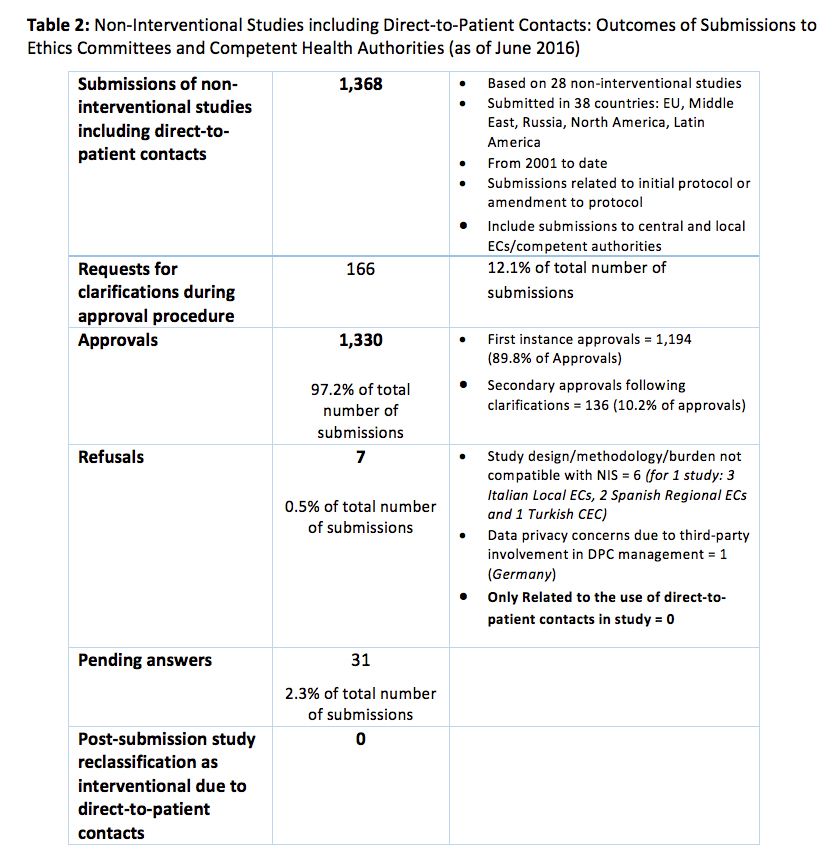Interventional vs. Non-interventional Study Classification in the EU: Considerations on the Impact of Direct-to-Patient Contacts
A new clinical trial regulation in Europe aims to bring about harmonization of European Union (EU) clinical trial multi-country applications. This paper poses a consensual review, fine-tuning, and validation of study classification while further clarifications on this law are sought out.
On April 16, 2014, the European Parliament and the Council on clinical trials on medicinal products for human use repealed clinical trials Directive 2001/20/EC and adopted a new Clinical Trials Regulation (EU) No 536/2014.1 The new Regulation, which does not directly apply to non-interventional studies (i.e., defined in Article 2 of the Regulation as any clinical study other than a clinical trial), became applicable on May 28, 2016. Its aims are to bring about harmonization of European Union (EU) clinical trial multi-country applications and reporting processes, shorten trial approval timelines, simplify safety data reporting requirements, and provide more transparency on clinical trial data. The new law states that global clinical trials must comply with regulatory requirements that are at least equivalent to those applicable in the EU if they include a clinical trial application within the EU.
While the new Regulation maintains the definition of a clinical trial as defined in Directive 2001/20/EC,2 it has also introduced a new subtype of clinical trial called the “low-intervention clinical trial.” In order to be classified as an interventional clinical trial, a study must first meet any of the following three criteria:
- Assignment of the subject to a particular therapeutic strategy is decided in advance and does not fall within normal clinical practice (i.e., the treatment regime typically followed to treat, prevent, or diagnose a disease or a disorder) of the member state concerned.
- The decision to prescribe the investigational medicinal products is taken together with the decision to include the subject in the clinical study.
- Diagnostic or monitoring procedures in addition to normal clinical practice are applied to the subjects.
The low-intervention clinical trial, on the other hand, must meet all of the following three criteria:
- The investigational medicinal products, excluding placebos, are authorized.
- According to the trial protocol, the investigational medicinal products are used in accordance with the terms of the marketing authorization or the use of the investigational medicinal products is evidence-based and supported by published scientific evidence on the safety and efficacy of those investigational medicinal products in any of the Member States concerned.
- The additional diagnostic or monitoring procedures do not pose more than minimal additional risk or burden to the safety of the subjects compared to normal clinical practice in any member state concerned.
For years, there has been uncertainty when designing protocols of whether inclusion of specific diagnostic or monitoring procedures would cause a planned non-interventional post-authorization study to be classified as an interventional clinical trial that is subject to Directive 2001/20/EC. Because there has been no EU-wide standardization, some countries have considered some procedures as non-interventional, while others have considered them interventional and subject to the Directive. Certain countries have even determined that an arbitrary volume or number of non-interventional procedures crosses the line and pushes a study into an interventional classification.
Fortunately, there are published documents that have served as aids in decision-making when designing non-interventional study protocols that include procedures, especially clinical rating procedures and patient surveys. These include the definition of a non-interventional study as detailed in GVP Annex I- Definitions (Rev 2) December 19, 2013,3 stating that “in these studies, interviews, questionnaires and blood samples may be performed as normal clinical practice”; the decision tree (see Table 1) to establish whether a study is an interventional clinical trial as annexed in Volume 10-Guidance documents applying to clinical trials, Questions & Answers, version 11.0 - May 2013;4 and the European Network of Centers for Pharmacoepidemiology and Pharmacovigilance (ENCePP) position paper “ENCePP considerations of the definition of non-interventional trials under the current legislative framework” issued on November 22, 2011.5

The ENCePP document outlines four specific characteristics of study procedures, at least one of which should be met, in order for the study procedure to be considered as part of normal clinical practice. These include:
- The procedure is routinely performed by a proportion of healthcare professionals.
- The procedure is performed according to evidence-based medicines criteria.
- The procedure is defined in guidelines issued by a relevant medical body.
- The procedure is mandated by regulatory and/or medical authorities; and/or is reimbursed by the national or private health insurance.
The document also describes some general principles for study procedures to be seen as non-interventional:
- The use of validated patient reported outcomes is non-interventional, where evidence-based medicine criteria and/or other relevant guidelines recommend their use for diagnostic or monitoring purposes or to measure outcomes.
- Interviews and questionnaires should not lead to a change in behavior or influence treatment and should be as short as needed to reach the objectives of the non-interventional trial.
- Further analysis of already drawn blood need not be seen as interventional, although such analyses have to be approved by ethics committees.
Unfortunately, the new Regulation’s attempt at providing greater clarity and simplification of clinical trials may have led to more ambiguity in the design, regulatory approval pathway, and operationalization of post-authorization clinical studies. The Regulation’s absence of reference to the prior clarification of procedures considered part of normal practice provided in Eudralex Volume 9A leaves room for interpretation and interrogation by several stakeholders, including sponsors, investigators, ethics committees (ECs), and regulatory authorities in the different EU member states.
One study type that is at risk of being classified as an interventional clinical trial is the prospective (or ambispective, i.e. combined retrospective and prospective data collection) post-authorization observational cohort study with patient-reported data proactively collected outside routine office clinical care visits. These studies frequently collect data from iterative and proactive direct-to-patient contacts (DPC), i.e., contacts performed outside a patient visit to the physician’s office. Most of the time these contacts occur independently from the patient’s physician using a variety of communication methods (e.g., postal mailing, telephone, email, push-pull text messages, smart phone application, and other Internet-based systems). They are performed for several purposes depending on the study objectives, including patient-reported outcomes (PRO) data collection, to ease study participation, or to optimize retention/lost-to-follow-up rates.
It is not yet clear whether the new Regulation interprets DPC as fulfilling the low-intervention clinical trial criteria of “additional diagnostic or monitoring procedures that do not pose more than minimal additional risk or burden to the safety of the subjects compared to normal clinical practice.” We believe this would be an unfortunate ramification since we have never experienced a non-interventional study designed with DPC that have been reclassified as interventional due solely to the DPC process in our 16-year history of submitting such studies to ECs and health authorities (see Table 2). One study was denied as compatible with a non-interventional study due to a combination of factors, including general study design and burden of study requirements on sites and patients.

Typically, ECs and health authority requests for clarifications have been related to confidentiality and data privacy concerns rather than to the DPC process itself. One should distinguish data privacy and professional confidentiality considerations (i.e., who has the legitimacy for contacting patients and collect health data and how to manage these contacts to comply with regulations) from the purpose and content of the contacts and their consequences on the interventional/non-interventional classification of the study.
Attendees at the June 2015 joint DIA/EMA information day on post-authorization studies in London, particularly the pharmaco-epidemiological community, expressed concerns and expectations for a clear and consensual definition of a non-interventional study. EMA representatives gave the audience some reassurance on this point, clarifying that the purpose of defining this new category of low-intervention clinical trial was indeed to simplify their management and not to migrate non-interventional post-authorization studies into the new clinical trial Regulation. Timelines for issuing Regulation clarifications have not been issued yet, but in the interim, participants were advised to provide sound analysis and arguments to ECs and competent local authorities on a case-by-case basis during discussions regarding study classification as non-interventional vs. interventional clinical trial. They also reminded the audience that the considerations of a non-interventional study as detailed in GVP Annex I- Definitions (Rev 2) \ and the ENCePP position paper are still to be considered as well.
As we wait for further clarification of the new clinical trial Regulation, the pre-defined ENCePP paper criteria provides an orientation as to whether DPC is likely to be seen as non-interventional, especially in post-authorization observational cohort studies that involve prospective data collection. Based on our experience in patient-centric research, we would also add complementary criteria that we believe would categorize patient contacts, especially DPC, as non-interventional procedures. Consequently, the criteria checklist we propose is the following:
1. The concerned patients are routinely contacted by at least a proportion of healthcare professionals.
2. An active patient follow-up is mandated or recommended by regulatory and/or medical authorities in guidelines or in the summary of product characteristics of concerned products.
3. Assessment or contact frequency, content, and burden on the patient are unlikely to lead to a change in patient behavior or influence patient perspective on the treatment when:
- The contacts will not provide advice or induce guidance on product use.
- The contacts cannot reasonably be considered as training, an educational process, or an efficient way to reinforce acceptance of the treatment, compliance, and persistence.
- The contact content is unlikely to induce changes in perception of the treatment by the patient (e.g., safety and efficacy of a product).
- The contacts and their content cannot reasonably have a negative and strong psychological impact on patients (e.g., cannot trigger suicidal ideas through intrusive questions to patients with severe depressive disorders).
- The frequency of contacts is unlikely to play the role of regular and efficient reminders for taking a product (or carrying out planned therapeutic procedures) and to generate the perception by patients of being under close surveillance for good use of the products.
4. The frequency and duration of patient contacts fit with the study objectives and would not be expected to induce a significant unusual burden on study patients compared to non-study patients having the same condition.
5. Following patient contacts, there is no expedited reporting of individual medical outcomes (e.g., symptom assessments) to prescribers likely to change prescriber behavior toward patient treatment (except for safety considerations). Assessments would be clearly perceived by investigators as a collection of data for aggregated outcomes of a study and not a way to continuously monitor the treatment effects and adjust it accordingly.
Conclusion
From our vast and lengthy past experience in patient-centered research, incorporation of patient-reported data in post-authorization study designs, especially when collected via DPCs, seem to have a very limited impact on regulatory study classification as an interventional clinical trial vs. non-interventional study. However, this could change given the debate around the new Clinical Trials Regulation. While waiting for further clarifications, it is worthwhile to be prepared for these discussions using the criteria as proposed in this paper. Consensual review, fine-tuning, and validation of these criteria would be beneficial to enhance common understanding of study classification.
Xavier Fournie, MD, is EVP, Global Medical Affairs; Jean Siebenaler, MD, MPH, is Senior Medical Director; Sandra Wiederkehr, PhD, is Project Director, Direct-to-Patient Contacts; all with Mapi - Real-World Evidence
References
- http://ec.europa.eu/health/human-use/clinical-trials/regulation/index_en.htm
- http://ec.europa.eu/health/human-use/clinical-trials/directive/index_en.htm
- http://www.ema.europa.eu/docs/en_GB/document_library/Scientific_guideline/2014/04/WC500165593.pdf
- http://ec.europa.eu/health/files/eudralex/vol-10/ctqa_v11.pdf
- http://www.encepp.eu/structure/documents/ENCePPconsiderationsNIS.pdf